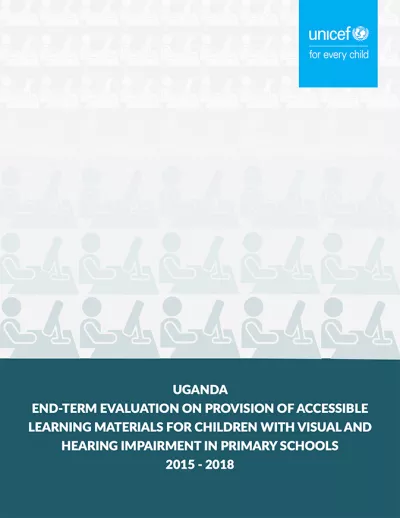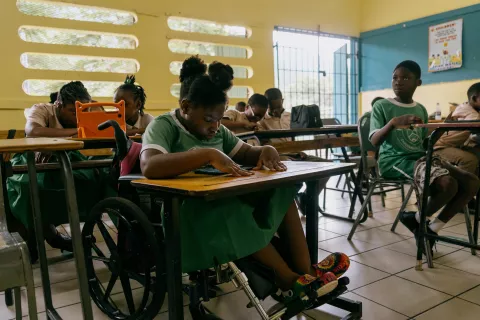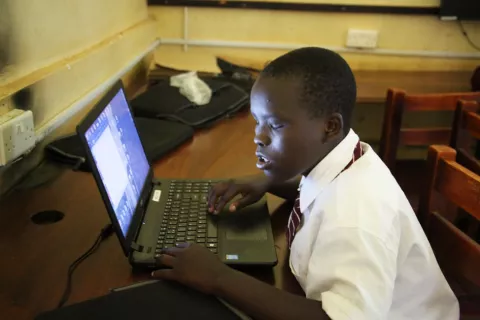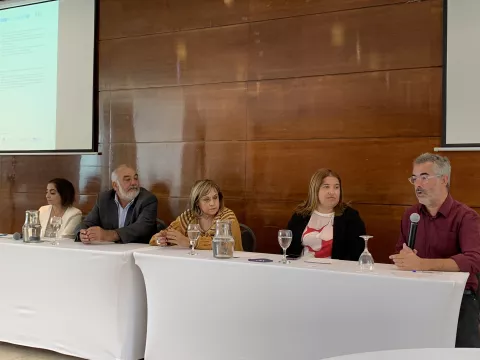Uganda Pilot
UNICEF and UNESCO joint project funded by UNPRPD

- Available in:
- English
- Español
Uganda has embraced inclusive education and is committed to improving inclusion of children with who are blind/low vision and children who are deaf of hard of hearing in education. This is evident from the rich policies in the country and the international conventions Uganda signed. However, policy implementation remains weak and so there are still a number of gaps in the provision of education for children with disabilities. UNICEF, together with the Ministry of Education and Sports (MoES), designed a Project to provide accessible textbooks and learning materials for children who are blind or low vision and those who are deaf or hard of hearing and address some of the gaps that exist in learning.
English Language textbooks for Grades Four (4) and Six (6) were adapted and produced in three formats: audio materials for children with low vision and/or blind, large text HTML and enhanced graphic materials for children with low vision and sign language materials for children who are deaf. In addition, Teachers’ Guides were also developed and piloted in 20 inclusive/integrated schools.
Results
80 trained teachers
80% have enhanced competence in pedagogy and confidence in the use of ICTs to support the learning of pupils with disabilities in their classroom.
20 trained head teachers
100% have improved knowledge and skills in the use of these accessible materials and easily provide support and supervision to the teachers.
20 pilot schools
455 learners with disabilities
(206 boys and 249 girls);
1,014 stakeholders
including DPOs were trained on inclusive accessible materials.
Findings show that:
- “The use of assistive technologies has motivated children with disabilities to love school. The learners preferred to be at school than their homes. They attribute this change of attitude to the introduction of the assistive technologies;
- The teachers expressed that the participation of children with disabilities improved to a level that is equal to that of children without disabilities. The technologies levelled the ground for learning for the children with disabilities and made them equal learners, participating in learning in class with their peers.
- Learner classroom participation and interaction has increased;
- Learning achievements has improved.;
- At Kamurasi Primary, two blind learners passed the primary examinations in 2018 and are the first blind learners graduating from this primary school and admitted at high school.
- With assistive technologies, children with disabilities participate in class activities. A teacher in Gulu Primary school noted. “Children’s participation when using these technologies has increased….it is as if there is another teacher. Their attention and participation has increased.” Moreover, children enjoy school more now…….
"I love using the computer. When I go back home, I miss school. My family members go to the garden; I stay home and wish I was in school”
Learner who is blind, Spire Road Primary School - Jinja
Report
Uganda has embraced inclusive education and is committed to improving the inclusion of children with visual and hearing impairment in education. This is evident from the country’s rich policies and the international conventions Uganda is signatory to. However, policy implementation remains weak and so there are still a number of gaps in the provision of education for children with disabilities, including those with Visual Impairment (VI) and Hearing Impairment (HI). It is, therefore, for this reason that UNICEF, together with the Government of Uganda, designed a project to provide Accessible Learning Materials for children with Visual and Hearing Impairment and address some of the gaps that exist. This report presents findings of the evaluation of this project.





